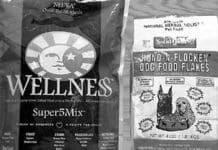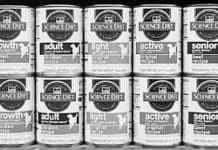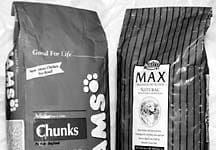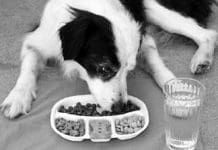Whole Dog Journal’s 2001 Canned Dog Food Review
or fish broth is used in place of water.
We looked for the use of whole grains and vegetables
The Difference Between Quality Dog Treats and Unhealthy Dog Treats
There are two types of people in the world: Those who give their dogs treats, and those who don’t, ever. I think all of us here belong in the former group. Right? Everyone with me? Good. We are all aware that we could make our own dogs treats rather than buy them. Some of us do make our dogs’ treats, sometimes. But there is something special about buying snacks for our dogs – sort of like buying Popsicles from the ice cream man for the kids; it may be expensive, and impulsive, and foolish. But so what? The joyous little doggie dance that dogs do when they know you’ve got something yummy for them is worth any price.
The Facts You Need Before Feeding Your Dog a Fiber Regiment
There has been renewed interest in fiber as a dog food ingredient. One pet food manufacturer published an article on the Internet condemning beet pulp in dog food as unhealthy, if not downright dangerous. There is a lot of myth and misunderstanding concerning fiber, so let's take a closer look at this controversial ingredient.The term fiber" (or "roughage") applies to complex carbohydrates that are resistant to mammalian digestive enzymes
The Benefits of Feeding Your Dog Milk
My dog drinks about a half-cup of organic milk (same as I drink) with his evening meal. He is a strong, healthy 10-year-old dog, and has never had any problems with arthritis or digestive troubles. My husband, though, is certain that milk is bad for dogs. I look at my dog and feel certain I've been doing things right; he looks great. Is there any reason to discontinue his milk?
Pet Food Labeling Regulations – Know The Facts!
Virtually every dog food on the market complies with the labeling regulations and meets the nutrient standards suggested by the Association of American Feed Control Officials (AAFCO); go look at the fine print on your dog’s food label. It will have one of two statements on it, indicating which of two AAFCO standards it supposedly met: either a “feeding trial” or chemical analysis of the food. The problem is, that particular food may have passed neither test itself.
Let Them Eat Grass!
mucus
The Nutritional Adequacy of Raw Food Diets
Research is needed to analyze the nutritional adequacy of raw food diets. However, a published study didn’t accomplish that goal. The Journal of the American Veterinary Medical Association (JAVMA) published an article written by two veterinarians about homemade and commercially made raw meat-based diets. (A similar article, based on the same data, was published in the AKC Gazette.) The article has been regarded by many proponents of homemade diets as a warning shot fired by the commercial-food -producing community and their traditional veterinary medical footsoldiers over the bow of the raw feeding ship.
Iams vs. Nutro: An Update
It’s unfortunate that The Iams Company was not given the opportunity to provide relevant background information and a scientific point of view prior to...
Comparing the Best Raw Dog Food Diet Plans
Have you ever noticed that dog owners tend to select one canine expert to follow in the area of dog nutrition and dog food and then another expert for training? And they’ll often adhere to their personal guru’s program no matter what? Is it our unconscious dog-like loyalty, or what? Many of our readers are already preparing their own dog food, and generally, they are following the guidelines of some canine nutrition expert. However, many more of our readers have not yet sorted out the differences between the raw dog food diets being promoted today.
A Variety of Dog Food is the Spice of Life . . .
We would think a pediatrician who recommended a single food diet for a child was bonkers, yet when the veterinarian recommends a single food for our pampered pooch, we obey without question. Yet, feeding a dog is not all that different from feeding a kid. There are numerous reasons why a dog should eat different foods on a regular basis – if not a fresh, ever-changing homemade diet, then at least a rotating commercial diet. We like to think of the production of food, even pet food, as a fairly scientific affair but the truth is, all pet food manufacturers make mistakes in formulation or production that result in nutrient excesses or deficiencies.
How To Read Dog Treat Labels
Most of us just can’t resist giving our beloved canine friends a little snack now and then. Many of us are trained by our dogs to run for the doggie biscuits at the cock of a brow, a whimper and a nudge, otherwise known as “the biscuit shuffle.” I am convinced there is a biscuit “look” that no one can refuse. Treats are fine; after all, we snack between meals! But, just as with our snacks, what treats you choose to give your dog should contribute – not take away from – the overall healthfulness of his diet. There is a huge variety of biscuits on the market in these dog-friendly days, and variety is great for our canine friends, as long as we know which ingredients to seek and which to avoid.
The Best Dog Food Bowls
Consider your dog's dinnerware, a topic more complicated than you might have thought. A visit to your local pet superstore, for example, will reveal dozens of choices, in plastic, stainless steel, glass, nylon, ceramic, and possibly aluminum. Among them are many simple, practical and economical models, meant for long-term everyday use, which are the focus of this article. Of course, bowls also come in a million different specialty" models to feed automatically


















